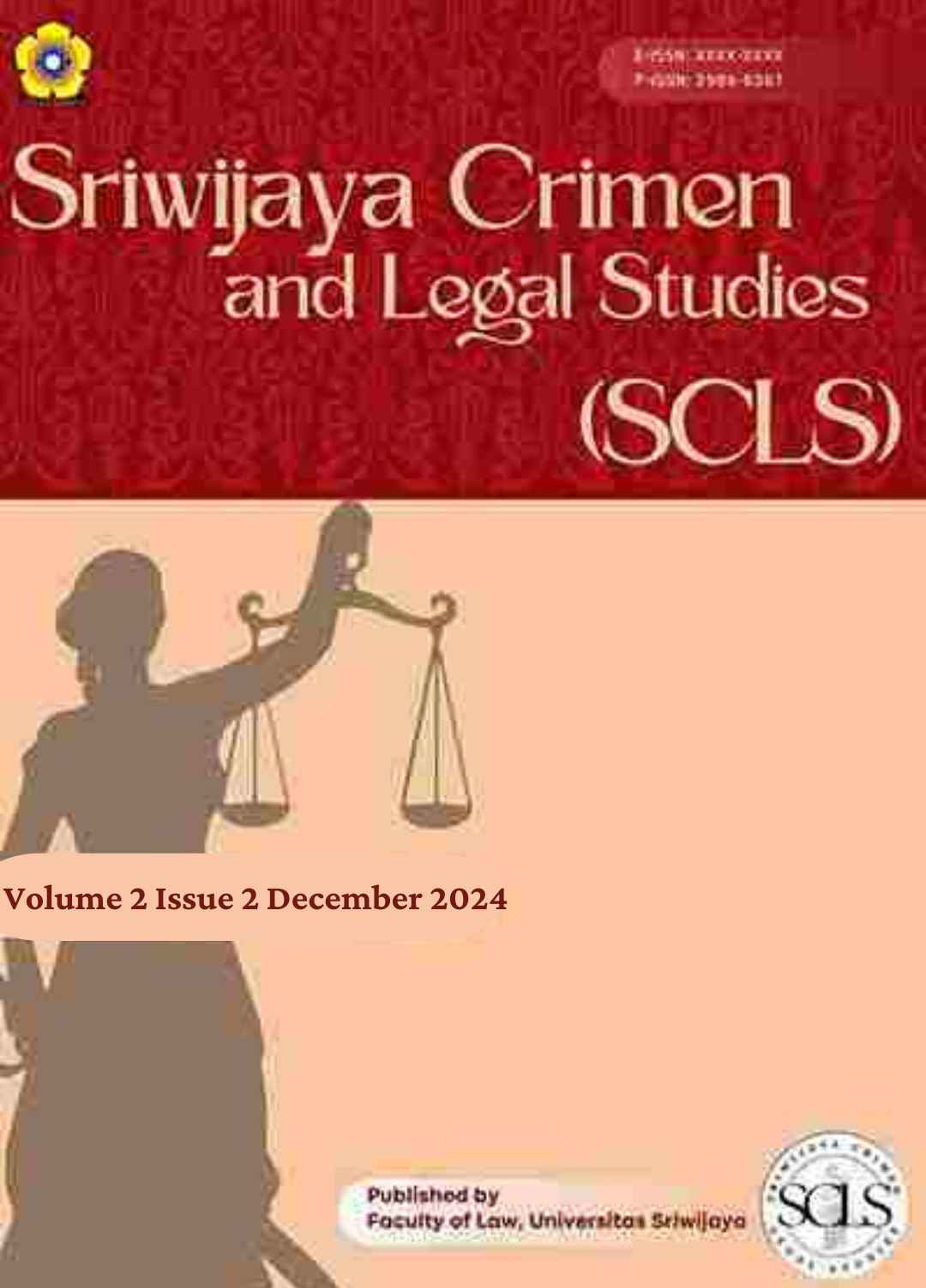CRIMINOLOGICAL ANALYSIS OF CYBERBULLYING CRIMES OCCURRING ON SOCIAL MEDIA (STUDY OF COMMENTS ON THE TIKTOK ACCOUNT ELYNAWA21)
DOI:
https://doi.org/10.28946/scls.v2i2.4118Abstract
This research aims to examine the phenomenon of crime in the social media landscape, particularly cyberbullying, which has become increasingly prevalent. The primary focus is on how the development of information and communication technology has facilitated bullying on social media platforms. Utilizing the social control theory by Travis Hirschi and Michael Gottfredson, this study emphasizes that individuals with weak attachments to social institutions, such as family, school, or community, are more susceptible to engaging in criminal behavior, including cyberbullying. This study analyzes comments targeting the physical appearance of individuals, where the lack of social supervision and weak self-control are identified as key factors contributing to cyberbullying behavior. Additionally, a low awareness of legal frameworks, such as the ITE Law governing online harassment, further intensifies this issue. The novelty of this research lies in applying social control theory within the context of cyberbullying on social media, highlighting the importance of strengthening social bonds and implementing social control mechanisms as preventive strategies. The study also provides valuable insights into the need for more effective law enforcement and educational efforts to mitigate and address the rising cases of cyberbullying in the digital age.References
Abidin, Achmad Zainal, and Ida Rachma. “Etnografi Virtual Sebagai Teknik Pengumpulan Data Dan Metode Penelitian.†The Journal of Society & Media 2, no. 2 (2018): 130–45. https://journal.unesa.ac.id/index.php/jsm/index.
Alfiyana, Ni Kadek Nisa. “TINJAUAN KRIMINOLOGI TINDAK KEKERASAN BULLYING DI KALANGAN PELAJAR.†Jurnal Interpretasi Hukum 2, no. 1 (2022): 269–274.
Anggraini, and Gunawan Bambang Indra. “UPAYA HUKUM PENGHINAAN (BODY SHAMING) DIKALANGAN MEDIA SOSIAL MENURUT HUKUM PIDANA DAN UU ITE.†Lex Justitia 1, no. 2 (2019): 114–124.
Chandra, Tofik Yanuar. Hukum Pidana. Yogyakarta: Sangir Multi Usaha, 2015.
Diantha, I Made Pasek. Metodologi Penelitian Hukum Normatif Dalam Justifikasi Teori Hukum. Jakarta: Kencana Prenada Media Group, 2016.
Djanggih, Hardianto, and Nurul Qamar. “Penerapan Teori-Teori Kriminologi Dalam Penanggulangan Kejahatan Siber (Cyber Crime).†Pandecta: Research Law Journal 13, no. 1 (2018): 10–23. https://doi.org/10.15294/pandecta.v13i1.14020.
Fajar, Mukti, and Yulianto Achmad. Dualisme Penelitian Hukum Normatif Dan Empiris. Yogyakarta: Pustaka Pelajar, 2010.
Idrus, Nur Fadilah Al, and Yeni Widowati. “Cyberbullying Di Media Sosial Dalam Prespektif Kriminologis Dan Viktmologis.†DIVERSI : Jurnal Hukum 8, no. 2 (2022): 217. https://doi.org/10.32503/diversi.v8i2.2233.
Ismail, Ismail, and Andi Maysarah. “TINJAUAN KRIMINOLOGI TINDAK KEKERASAN BULLYING TERHADAP ANAK DI KABUPATEN ASAHAN (Studi Di Komisi Perlindungan Anak Daerah Kabupaten Asahan).†Warta Dharmawangsa 18, no. 1 (2024): 9–23. https://doi.org/10.46576/wdw.v18i1.4253.
Kasidin, Sunarko, and Refaldy Wiragama. “Kebijakan Uu Ite Dalam Mengatasi Tindak Pidana Pelaku Cyber Bullying (Perundungan Dunia Maya) Di Social Media.†FOCUS: Jurnal of Law 2, no. 2 (2022): 118–26. https://doi.org/10.47685/focus.v2i2.305.
Kristinawati, Valentina Pinky, and Edi Pranoto. “Tinjauan Yuridis Terhadap Tindak Pidana Bullying Di Sekolah.†Concept: Journal of Social Humanities and Education 2, no. 1 (2023): 241–59.
Liano Rovi Frederick Rumbay. “TINDAK PIDANA CYBERBULLYING DALAM MEDIA SOSIAL MENURUT UU NO. 11 TAHUN 2008 TENTANG INFORMASI DAN TRANSAKSI ELEKTRONIK.†Jurnal Akuntansi 11, no. 7 (2017): 142–50.
Meinarni, Ni Putu Suci. “Tinjauan Yuridis Cyber Bullying Dalam Ranah Hukum Indonesia.†Ganayaya: Jurnal Sosial Dan Humaniora 2, no. 1 (2019): 299–308. http://scioteca.caf.com/bitstream/handle/123456789/1091/RED2017-Eng-8ene.pdf?sequence=12&isAllowed=y%0Ahttp://dx.doi.org/10.1016/j.regsciurbeco.2008.06.005%0Ahttps://www.researchgate.net/publication/305320484_SISTEM_PEMBETUNGAN_TERPUSAT_STRATEGI_MELESTARI.
Mulyana, Andi Muhammad Agung, M. Syukri Akub, and Hijrah Adhyanti Mirzana. “Tinjauan Kriminologis Terhadap Tindak Pidana Kekerasan Oleh Anak Dalam Bentuk Perundungan (Bullying).†Jurnal Diskursus Islam 11, no. 2 (2023): 83–95. https://doi.org/10.24252/jdi.v11i2.34160.
Nastiti, B M, and L Primasari. “KAJIAN KRIMINOLOGI TINDAK PIDANA KEKERASAN MELALUI MEDIA ELEKTRONIK (CYBER BULLYING) MENGGUNAKAN MEDIA SOSIAL FACEBOOK (STUDI PUTUSAN PN KLATEN NOMOR: 23/PID.SUS/2015/PN KLN).†Recidive : Jurnal Hukum Pidana Dan Penanggulangan Kejahatan 5, no. 1 (2015): 1–10. https://jurnal.uns.ac.id/recidive/article/view/47756.
Rahman, Yulianis Safrinadiya. “Kejahatan Kekerasan Dan Brutalisme Massa (Perspektif Kriminologi).†Al-Adl : Jurnal Hukum 14, no. 2 (2022): 269. https://doi.org/10.31602/al-adl.v14i2.6284.
Setyawan, Sendy Agus, Mu’amar Gustaf, Muhammad Akbar Maulana Pambudi, Enggar Dias Fatkhurrozi, and Syaiful Anwar. “Pergaulan Bebas Di Kalangan Mahasiswa Dalam Tinjauan Kriminologi Dan Hukum.†Law Research Review Quarterly 5, no. 2 (2019): 135–58. https://doi.org/10.1027/1016-9040/a000314.
Sihotang, Agustin Pratama, Depi Yohana Manurung, Friska Lorentina Purba, Limra G M Nababan, Nasywa Yasmin Purba, and Ramsul Yandi Nababan. “Tinjauan Hukum Terhadap Tindakan Cyberbullying Oleh Remaja Dan Pencegahan Dalam Konteks Undang-Undang ITE.†Jurnal Komunikasi 1, no. 6 (2023): 285–93.
Sudaryono, and Natangsa Surbakti. HUKUM PIDANA DASAR-DASAR HUKUM PIDANA BERDASARKAN KUHP DAN RUU KUHP. Surakarta: Muhammadiyah University Press, 2017.
Susanti, Emilia, and Eko Rahardjo. Kriminologi. Bandar Lampug: Aura Publishing, 2015.
Tualeka, M. Wahid Nur. “Teori Konflik Sosiologi Klasik Dan Modern.†Al-Hikmah : Jurnal Studi Agama-Agama 3, no. 1 (2017): 32–48. https://journal.um-surabaya.ac.id/Ah/article/view/409.
Widodo. Kriminologi Dan Hukum Pidana. Semarang: Universitas PGRI Semarang Press, 2015.
Downloads
Published
Issue
Section
License
As a journal author, you have rights for a large range of uses of your article, including use by your employing institute or company. These Author rights can be exercised without the need to obtain specific permission.
Authors publishing in SCLS journals have wide rights to use their works for teaching and scholarly purposes without needing to seek permission, including: use for classroom teaching by Author or Author's institution and presentation at a meeting or conference and distributing copies to attendees; use for internal training by author's company; distribution to colleagues for their research use; use in a subsequent compilation of the author's works; inclusion in a thesis or dissertation; reuse of portions or extracts from the article in other works (with full acknowledgement of final article); preparation of derivative works (other than commercial purposes) (with full acknowledgement of final article); voluntary posting on open web sites operated by author or author’s institution for scholarly purposes (follow CC by SA License).
Authors and readers can copy and redistribute the material in any medium or format, as well as remix, transform, and build upon the material for any purpose, even commercially, but they must give appropriate credit (cite to the article or content), provide a link to the license, and indicate if changes were made. If you remix, transform or build upon the material, you must distribute your contributions under the same license as the original.


